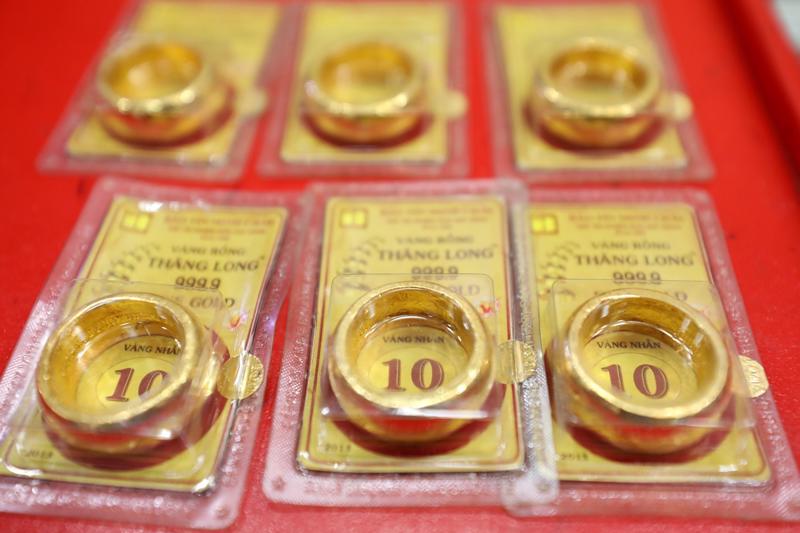Vietnam’s gold market witnessed significant volatility from March 4-10, primarily characterized by a robust upwards trend driven by substantial buying activity. This surge occurred alongside persistent low supply, attributed to the State Bank of Vietnam (SBV) delaying the announcement of revisions to Decree No. 24/2012/ND-CP, which oversees gold business operations.
Internationally, spot gold prices surged to a new all-time high, reaching $2,180 an ounce. There was notable demand domestically for gold, with many individuals increasing their purchases following the Lunar New Year (Tet) holiday and God of Wealth Day, held on the tenth day of the first lunar month.
Capital flowed predominantly towards gold, particularly gold rings, given their higher prices compared to internationally-converted Saigon Jewelry Company (SJC) gold bars. The investment landscape, meanwhile, lacked compelling options. Savings interest rates remained stagnant at historically-low levels, ranging from 1.7 per cent to 4.7 per cent per annum. The real estate sector has experienced sluggishness, while the stock market has begun to witness profit-taking pressure after a period of gains.
As of March 9, SJC gold bars were listed at VND79.5 million ($3,242) per tael for purchasing and VND82 million ($3,346) per tael for sale; both record-high prices. Throughout the week, SJC gold bars consistently reached new peaks, climbing to VND80.3 million ($3,272), VND80.5 million ($3,280), VND81 million ($3,298), and then VND82 million ($3,338) per tael.
Similarly, the price of gold rings soared to historic highs during the week, closing at VND70.85 million ($2,891) per tael for Dragon Thang Long gold from Bao Tin Minh Chau.
Consequently, over the past week, the price of gold rings surged by up to VND3 million ($122) per tael and occasionally surpassed VND71 million ($2,894). The price differential of gold rings compared to internationally-converted gold prices (based on bank rates) widened to VND5 million ($203) per tael.
In contrast, the price of SJC gold bars exceeded the internationally-converted gold price by VND16.1 million ($655) per tael.
Globally, on the trading day of March 4 the gold price hit a new all-time high, surpassing $2,080 an ounce. Following this, gold prices continued to climb, reaching above $2,150 and peaking at over $2,195 an ounce during the trading session on March 8. Eventually they closed at $2,180 an ounce, marking a 4 per cent increase compared to the preceding week. In addition to gold, both stock markets and Bitcoin also reached record highs.
Demand among central banks to boost gold prices in 2024

During 2023, Vietnam experienced a marginal decline in overall gold consumption demand, down 6 per cent year-on-year from 59.1 tonnes to 55.5 tonnes. Specifically, the bar and coin sector witnessed a modest decline to 40.4 tonnes, reflecting a 2 per cent fall compared to the previous year’s 41 tonnes, figures from the World Gold Council (WGC) reveal.
Despite this, investment in Vietnam increased notably in the fourth quarter, driven by investor response to price corrections. However, the heightened demand coupled with limited availability of gold investment products led to higher premiums on official SJC tael bars, reaching approximately $600-700 an ounce. Conversely, jewelry demand in Vietnam suffered a significant decline during 2023, plummeting 16 per cent to 15.1 tonnes. This decline was attributed to four consecutive quarterly year-on-year decreases, influenced by sluggish economic growth and relatively high inflation rates.
There have been numerous predictions in recent times regarding gold price fluctuations. One of the latest forecasts, coming from analysts at Citibank, suggest that gold prices may surge to $3,000 an ounce within the next 12-18 months. This increase is attributed to a crisis of confidence in the US dollar, leading central banks to double their gold purchasing power.
The recent update from the WGC reveals continued strong demand for gold annually. Total gold demand in 2023, encompassing both the over-the-counter (OTC) market and gold reserves, reached an all-time high of 4,899 tonnes. Central banks sustained their vigorous pace of gold purchases, with net purchases in 2023 totaling 1,037 tonnes, just 45 tonnes short of the record set in 2022. It is anticipated that central banks will persist in their gold buying in 2024, driven by relaxation of monetary policy in several countries. This trend is expected to exert upwards pressure on gold prices in the foreseeable future.
According to Mr. Shaokai Fan, Head of Asia-Pacific (ex-China) and Global Head of Central Banks at the WGC, the Council anticipated that central banks would persist in their gold buying, driven by monetary policy relaxation. However, it has refrained from commenting on specific price levels. Regarding the discrepancy between gold prices in Vietnam and internationally, the WGC attributes this to Vietnam’s gold import restrictions and the persistent demand for gold in the country.
This net purchasing pattern, he went on, typically reverses only during significant financial crises, prompting central banks to sell gold reserves. However, the probability of such an occurrence is minimal.
Vietnam to embrace a free gold market
As the disparity between the price of gold in Vietnam and the international market is currently quite noticeable, the SBV is assessing and suggesting revisions to Decree No. 24. Regarding strategies to align Vietnam’s gold price with global standards, Mr. Fan noted that the stringent policy on gold imports primarily contributes to the significant price difference domestically. The SBV will carefully deliberate on various approaches in amending Decree No. 24’s provisions. Any new regulations allowing gold imports are anticipated to narrow the price gap between domestic and international gold, safeguarding investor interests.
Gold imports will undoubtedly impact the macro-economy, Mr. Fan added. However, Vietnam’s foreign exchange reserves have strengthened notably. Despite its tight control over official gold imports, robust domestic demand persists and is met by various sources, both official and unofficial. Judicious amendments to Decree No 24 can therefore effectively manage official gold sources under government oversight.
Considering the insights and management frameworks applied in various countries’ gold markets, Mr. Fan offered some suggestions.
Globally, many countries effectively regulate their gold markets by treating gold as a financial asset rather than merely a physical commodity. Vietnam can glean valuable lessons from countries like China, India, and Turkey, which predominantly import gold yet effectively meet domestic demand.
In Vietnam, prior to the enactment of Decree No. 24, certain unofficial gold trading platforms caused significant economic repercussions, with speculative activities through these platforms raising concerns among regulatory bodies.
Nevertheless, once gold is regarded as a financial instrument, diverse management approaches will emerge. Vietnam can draw upon the experiences of developed countries in treating gold as a financial asset, potentially leading to speculative behavior. This understanding can help identify and implement measures to prevent and mitigate risks while ensuring the efficient operation of the gold market.









 Google translate
Google translate